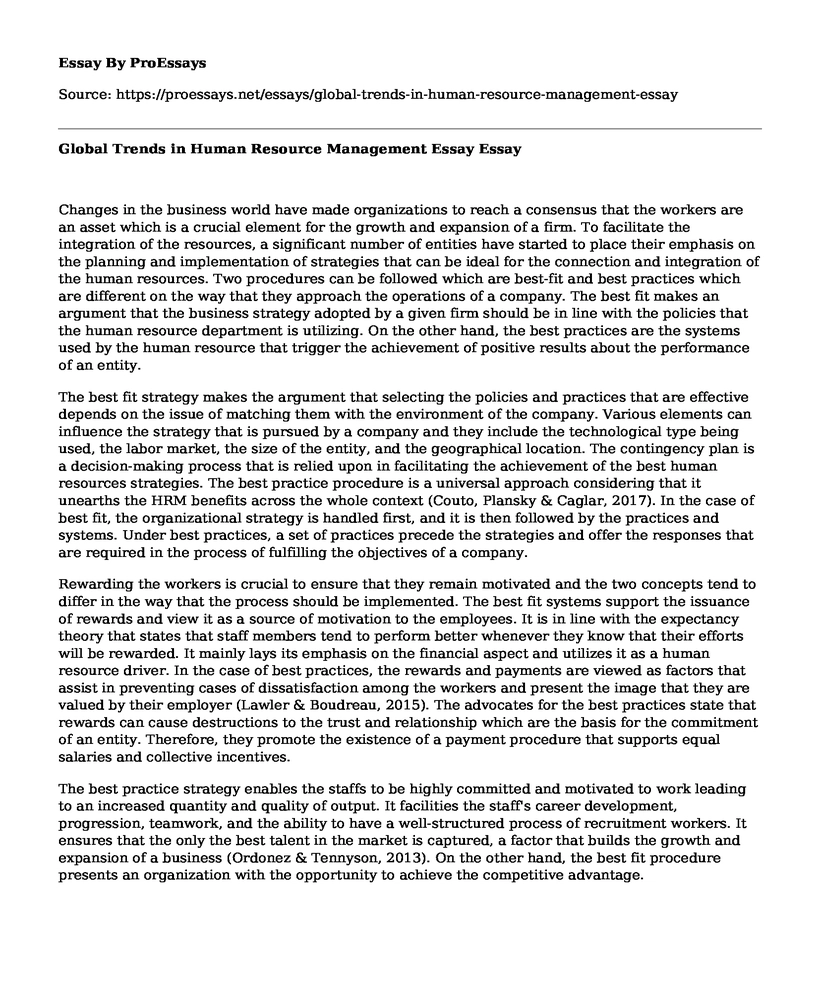Changes in the business world have made organizations to reach a consensus that the workers are an asset which is a crucial element for the growth and expansion of a firm. To facilitate the integration of the resources, a significant number of entities have started to place their emphasis on the planning and implementation of strategies that can be ideal for the connection and integration of the human resources. Two procedures can be followed which are best-fit and best practices which are different on the way that they approach the operations of a company. The best fit makes an argument that the business strategy adopted by a given firm should be in line with the policies that the human resource department is utilizing. On the other hand, the best practices are the systems used by the human resource that trigger the achievement of positive results about the performance of an entity.
The best fit strategy makes the argument that selecting the policies and practices that are effective depends on the issue of matching them with the environment of the company. Various elements can influence the strategy that is pursued by a company and they include the technological type being used, the labor market, the size of the entity, and the geographical location. The contingency plan is a decision-making process that is relied upon in facilitating the achievement of the best human resources strategies. The best practice procedure is a universal approach considering that it unearths the HRM benefits across the whole context (Couto, Plansky & Caglar, 2017). In the case of best fit, the organizational strategy is handled first, and it is then followed by the practices and systems. Under best practices, a set of practices precede the strategies and offer the responses that are required in the process of fulfilling the objectives of a company.
Rewarding the workers is crucial to ensure that they remain motivated and the two concepts tend to differ in the way that the process should be implemented. The best fit systems support the issuance of rewards and view it as a source of motivation to the employees. It is in line with the expectancy theory that states that staff members tend to perform better whenever they know that their efforts will be rewarded. It mainly lays its emphasis on the financial aspect and utilizes it as a human resource driver. In the case of best practices, the rewards and payments are viewed as factors that assist in preventing cases of dissatisfaction among the workers and present the image that they are valued by their employer (Lawler & Boudreau, 2015). The advocates for the best practices state that rewards can cause destructions to the trust and relationship which are the basis for the commitment of an entity. Therefore, they promote the existence of a payment procedure that supports equal salaries and collective incentives.
The best practice strategy enables the staffs to be highly committed and motivated to work leading to an increased quantity and quality of output. It facilities the staff's career development, progression, teamwork, and the ability to have a well-structured process of recruitment workers. It ensures that the only the best talent in the market is captured, a factor that builds the growth and expansion of a business (Ordonez & Tennyson, 2013). On the other hand, the best fit procedure presents an organization with the opportunity to achieve the competitive advantage.
Conclusion
To sum up, the best fit and best strategy are the procedures that the senior officers uses in ensuring that there is effectiveness in the management of a firm's operations. The policies and practices that are adopted by a firm should be in line with the activities of the business to ensure that the staffs are satisfied with the way they are handled. As a result, they will offer quality services to the customers at the same time enabling the business to achieve comparative advantage in the market.
References
Couto, V., Plansky, J., & Caglar, D. (2017). Fit for Growth: A Guide to Strategic Cost Cutting, Restructuring, and Renewal.
Lawler, E. E., & Boudreau, J. W. (2015). Global trends in human resource management: A twenty-year analysis.
Ordonez, . P. P., & Tennyson, R. D. (2013). Best practices and new perspectives in service science and management.
Cite this page
Global Trends in Human Resource Management Essay. (2022, Jul 25). Retrieved from https://proessays.net/essays/global-trends-in-human-resource-management-essay
If you are the original author of this essay and no longer wish to have it published on the ProEssays website, please click below to request its removal:
- Paper Example on Occupational Safety and Health Administration
- Health-Related Education and Experience Paper Example
- Recruiting Students - Research Paper
- Essay Sample on Motivation in Organizations in Saudi Arabia
- Essay Example on Lawyers Must Adapt to the Information Age to Attract New Clients
- Paper Example on Sexual Harassment in Business: Quid Pro Harassment
- The Power of Diversity: Leveraging Leadership for a Well-Diversified Workforce - Essay Sample







